-
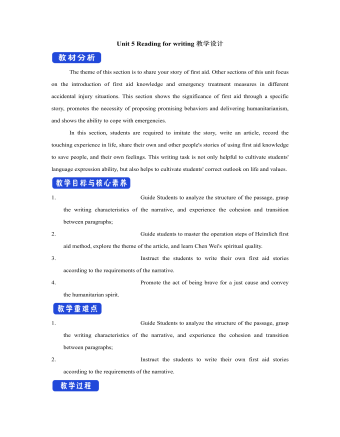
新人教版高中英语选修2Unit 5 Reading for writing教学设计
你校英语报计划出版一期急救常识专刊,现面向全校学生公开征集稿件,你有意参加。请你根据下面提示内容,用英语写一篇短文,介绍在车祸现场对伤者进行急救的方法和步骤。1.确保现场的安全;2.询问伤者,确保其呼吸正常;3.检查伤口,如流血则应采取止血措施;4.如需急救,确保其处于康复位置。注意:1.词数80左右;2.可以适当增加细节,以使行文连贯。参考词汇:康复位置 recovery positionAs we all know, having a knowledge of first aid can make a great difference in our daily life. If a traffic accident happens and someone is injured, the following steps can be used to treat the injured.In the first place, we should make sure that the accident scene is safe so that we won’t get hurt. We should ask the injured person if he is OK, and see if he is breathing. What’s more, we should check for cuts and wounds. If he is bleeding badly, it is vital that we should try to stop the bleeding by applying pressure to the injury. This is because if a person loses too much blood, he may die. If necessary, take the injured person to the hospital as soon as possible.Do remember: when giving first aid, please be sure to place the person in a recovery position.
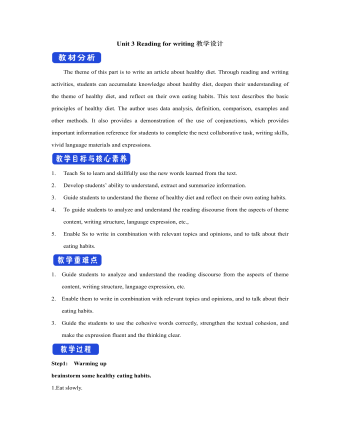
新人教版高中英语选修2Unit 3 Reading for writing教学设计
The theme of this part is to write an article about healthy diet. Through reading and writing activities, students can accumulate knowledge about healthy diet, deepen their understanding of the theme of healthy diet, and reflect on their own eating habits. This text describes the basic principles of healthy diet. The author uses data analysis, definition, comparison, examples and other methods. It also provides a demonstration of the use of conjunctions, which provides important information reference for students to complete the next collaborative task, writing skills, vivid language materials and expressions.1. Teach Ss to learn and skillfully use the new words learned from the text.2. Develop students’ ability to understand, extract and summarize information.3. Guide students to understand the theme of healthy diet and reflect on their own eating habits.4. To guide students to analyze and understand the reading discourse from the aspects of theme content, writing structure, language expression, etc., 5. Enable Ss to write in combination with relevant topics and opinions, and to talk about their eating habits.1. Guide students to analyze and understand the reading discourse from the aspects of theme content, writing structure, language expression, etc.2. Enable them to write in combination with relevant topics and opinions, and to talk about their eating habits.3. Guide the students to use the cohesive words correctly, strengthen the textual cohesion, and make the expression fluent and the thinking clear.Step1: Warming upbrainstorm some healthy eating habits.1.Eat slowly.2.Don’t eat too much fat or sugar.3.Eat healthy food.4.Have a balanced diet.Step2: Read the passage and then sum up the main idea of each paragraph.
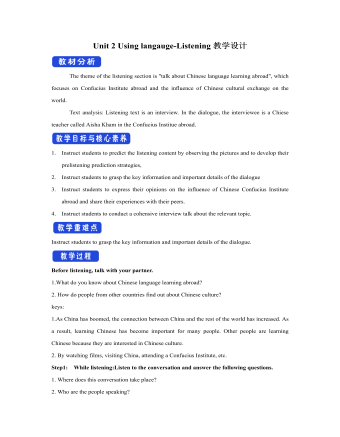
新人教版高中英语选修2Unit 2 Using langauge-Listening教学设计
? B: Absolutely! Getting involved with Chinese cultural activities there definitely helped a lot. I got to practice my Chinese on a daily basis, and I could learn how native Chinese speakers spoke.? A: What do you feel is your biggest achievement?? B: Learning Chinese characters! I have learnt about 1,500 so far. When I first started, I didn't think it was even going to be possible to learn so many, but now I find that I can read signs, menus, and even some easy newspaper articles.? A: What are you most keen on?? B: I've really become keen on learning more about the Chinese culture, in particular Chinese calligraphy. As I have learnt Chinese characters, I have developed a great appreciation for their meaning. I want to explore Chinese characters by learning how to write them in a more beautiful way. ? A: Finally, what do you want to say to anyone interested in learning Chinese?? I have really become keen on learning more about the Chinese culture, in particular Chinese Calligraphy. As I have learnt Chinese character, I have developed a great appreciation for their meaning. I want to explore Chinese characters by learning how to write them in a more beautiful way.? A: Finally, what do you want to say to anyone interested in learning Chinese?? B: I'd say, give it a shot! While some aspects may be difficult, it is quite rewarding and you will be happy that you tried.? A: Thanks for your time. ? B:You're welcome.
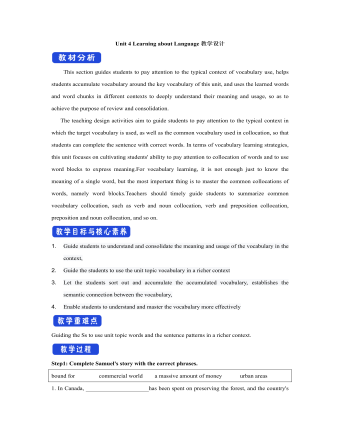
新人教版高中英语选修2Unit 4 Learning about Language教学设计
This section guides students to pay attention to the typical context of vocabulary use, helps students accumulate vocabulary around the key vocabulary of this unit, and uses the learned words and word chunks in different contexts to deeply understand their meaning and usage, so as to achieve the purpose of review and consolidation.The teaching design activities aim to guide students to pay attention to the typical context in which the target vocabulary is used, as well as the common vocabulary used in collocation, so that students can complete the sentence with correct words. In terms of vocabulary learning strategies, this unit focuses on cultivating students' ability to pay attention to collocation of words and to use word blocks to express meaning.For vocabulary learning, it is not enough just to know the meaning of a single word, but the most important thing is to master the common collocations of words, namely word blocks.Teachers should timely guide students to summarize common vocabulary collocation, such as verb and noun collocation, verb and preposition collocation, preposition and noun collocation, and so on.1. Guide students to understand and consolidate the meaning and usage of the vocabulary in the context, 2. Guide the students to use the unit topic vocabulary in a richer context3. Let the students sort out and accumulate the accumulated vocabulary, establishes the semantic connection between the vocabulary,4. Enable students to understand and master the vocabulary more effectivelyGuiding the Ss to use unit topic words and the sentence patterns in a richer context.

新人教版高中英语选修2Unit 5 Using langauge-Listening教学设计
The theme of this section is to learn how to make emergency calls. Students should learn how to make emergency calls not only in China, but also in foreign countries in English, so that they can be prepared for future situations outside the home.The emergency telephone number is a vital hotline, which should be the most clear, rapid and effective communication with the acute operator.This section helps students to understand the emergency calls in some countries and the precautions for making emergency calls. Through the study of this section, students can accumulate common expressions and sentence patterns in this context. 1.Help students accumulate emergency telephone numbers in different countries and learn more about first aid2.Guide the students to understand the contents and instructions of the telephone, grasp the characteristics of the emergency telephone and the requirements of the emergency telephone.3.Guide students to understand the first aid instructions of the operators.4.Enable Ss to make simulated emergency calls with their partners in the language they have learned1. Instruct students to grasp the key information and important details of the dialogue.2. Instruct students to conduct a similar talk on the relevant topic.Step1:Look and discuss:Match the pictures below to the medical emergencies, and then discuss the questions in groups.
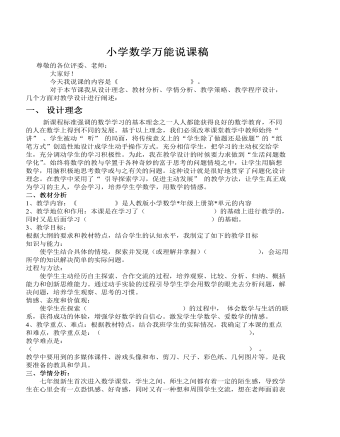
小学数学万能说课稿
一、 设计理念新课程标准强调的数学学习的基本理念之一人人都能获得良好的数学教育,不同的人在数学上得到不同的发展。基于以上理念,我们必须改革课堂教学中教师始终“讲”、学生被动“听”的局面,将传统意义上的“学生除了做题还是做题”的“纸笔方式”创造性地设计成学生动手操作方式。充分相信学生,把学习的主动权交给学生,充分调动学生的学习积极性。为此,我在教学设计的时候要力求做到“生活问题数学化”。始终将数学的教与学置于各种奇妙的富于思考的问题情境之中,让学生用脑想数学,用脑积极地思考数学或与之有关的问题。这种设计就是很好地贯穿了问题化设计理念。在教学中采用了“引导探索学习,促进主动发展”的教学方法,让学生真正成为学习的主人,学会学习,培养学生学数学,用数学的情感。

初中语文《社戏》试讲稿_教案设计
1 . 品味文章重点词语、句子或段落。 指导学生找出自己认为精彩、重要的词语、句子和段落,然后用旁批写下自己的看法。 词语例:“我们已经点开船,在桥石上一磕,退后几尺,即又上前出了桥。于是架起两支橹,一支两人,一里一换,……”“点”“磕”“退”“上”“架”等几个动词,将少年们开船时的动作程序以及合作划船的情状表述得颇为详细,显示了他们熟练的驾船技巧和勤劳肯干的品格,也折射出他们去看戏时的愉快心情。 句子例:“那航船,就像一条大白鱼背着一群孩子在浪花里蹿,连夜渔的几个老渔父,也停了艇子看着喝采起来。”这一句用一个富有童话色彩的比喻,反映了儿童富于幻想的 特点和愉快的心情。写老渔父的喝彩,是通过旁观者的赞美来衬托孩子们的驾船技术。 段落例:月夜行船一段(第11段)的景物描写分别从色彩、声音、视觉、听觉、嗅 觉各个侧面着笔,恰如多重奏管弦曲,给人以十分丰富的感觉,景物的立体感由此产生。
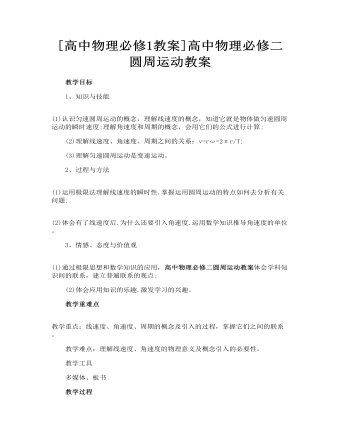
高中物理必修二圆周运动教案
1、知识与技能 (1)认识匀速圆周运动的概念,理解线速度的概念,知道它就是物体做匀速圆周运动的瞬时速度;理解角速度和周期的概念,会用它们的公式进行计算; (2)理解线速度、角速度、周期之间的关系:v=rω=2πr/T; (3)理解匀速圆周运动是变速运动。 2、过程与方法 (1)运用极限法理解线速度的瞬时性.掌握运用圆周运动的特点如何去分析有关问题; (2)体会有了线速度后.为什么还要引入角速度.运用数学知识推导角速度的单位。
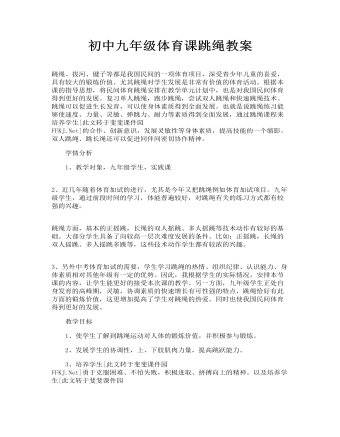
初中九年级体育课跳绳教案
1、教学对象,九年级学生,实践课 2、近几年随着体育加试的进行,尤其是今年又把跳绳例如体育加试项目。九年级学生,通过前段时间的学习,体能普遍较好,对跳绳有关的练习方式都有较强的兴趣。 跳绳方面,基本的正摇跳,长绳的双人摇跳、多人摇跳等技术动作有较好的基础。大部分学生具备了向较高一层次难度发展的条件。比如:正摇跳,长绳的双人摇跳、多人摇跳多跳等,这些技术动作学生都有较浓的兴趣。 3、另外中考体育加试的需要,学生学习跳绳的热情、组织纪律、认识能力、身体素质相对其他年级有一定的优势。因此,我根据学生的实际情况,安排本节课的内容,让学生能更好的接受本次课的教学。另一方面,九年级学生正处自身发育的高峰期,灵敏,协调素质的快速增长有可性强的特点,跳绳恰好有此方面的锻炼价值,这更增加提高了学生对跳绳的热爱。同时也使我国民间体育得到更好的发展。
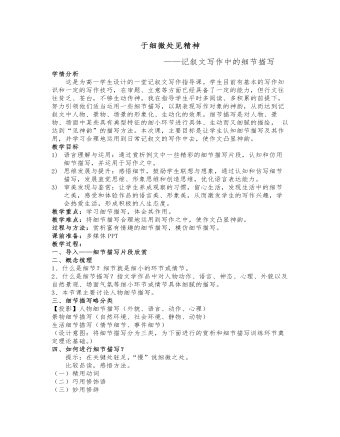
高中语文作文课教案说课稿模板
教学目标1) 语言理解与运用:通过赏析例文中一些精彩的细节描写片段,认知和仿用细节描写,并运用于写作之中。2) 思维发展与提升:感悟细节,鼓励学生联想与想象,通过认知和仿写细节描写,发展直觉思维、形象思维和创造思维,优化语言表达能力。3) 审美发现与鉴赏:让学生养成观察的习惯,留心生活,发现生活中的细节之美,感受和体验作品的语言美、形象美,从而激发学生的写作兴趣,学会热爱生活,形成积极的人生态度。

小学生综合实践活动教案设计方案
(1)第一环节:讲解活动主题,提出问题讨论 1.让学生们说一说自己有哪些习惯。 2.老师根据学生发言,对习惯进行简单的分类,如分为生活习惯和学习习惯,好的习惯和坏的习惯等等,并在黑板上进行板书,大纲式列出来。 3.老师进行归纳小结:习惯是一种态度,同学们说的习惯中,有生活习惯、有学习习惯,有些是好的习惯,有的是坏的习惯。其实从我们出生的那一天,我们就开始有意无意地养成习惯......比如今天,当我们走进课堂,其实就已经开始了“好好学习”这个习惯养成的第一步....

小学生综合实践活动教案设计方案
(1)第一环节:讲解活动主题,提出问题讨论 1.让学生们说一说自己有哪些习惯。 2.老师根据学生发言,对习惯进行简单的分类,如分为生活习惯和学习习惯,好的习惯和坏的习惯等等,并在黑板上进行板书,大纲式列出来。 3.老师进行归纳小结:习惯是一种态度,同学们说的习惯中,有生活习惯、有学习习惯,有些是好的习惯,有的是坏的习惯。其实从我们出生的那一天,我们就开始有意无意地养成习惯......比如今天,当我们走进课堂,其实就已经开始了“好好学习”这个习惯养成的第一步....
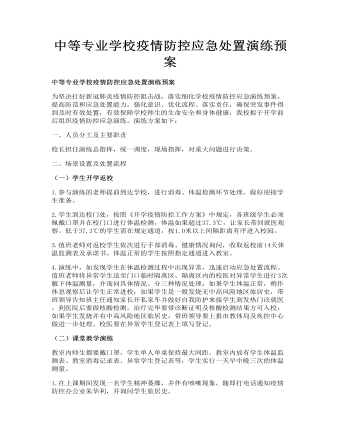
中等专业学校疫情防控应急处置演练预案
1.参与演练的老师提前到达学校,进行消毒、体温检测环节处理,做好迎接学生准备。2.学生到达校门处,按照《开学疫情防控工作方案》中规定,各班级学生必须佩戴口罩并在校门口进行体温检测,体温如果超过37.3℃,让家长带回就医观察。低于37.3℃的学生需在规定通道,按1.0米以上间隔距离有序进入校园。3.值班老师对返校学生依次进行手部消毒、健康情况询问,收取返校前14天体温监测表及承诺书。体温正常的学生按照指定通道进入教室。
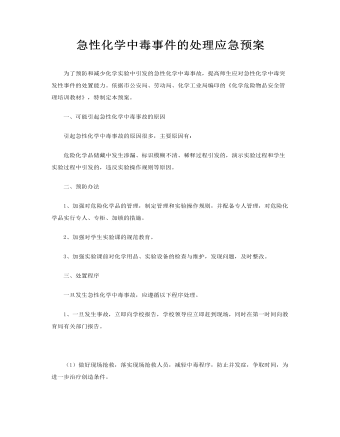
急性化学中毒事件的处理应急预案
1、加强对危险化学品的管理,制定管理和实验操作规则,并配备专人管理,对危险化学品实行专人、专柜、加锁的措施。 2、加强对学生实验课的规范教育。 3、加强实验课前对化学用品、实验设备的检查与维护,发现问题,及时整改。 三、处置程序 一旦发生急性化学中毒事故,应遵循以下程序处理。 1、一旦发生事故,立即向学校报告,学校领导应立即赶到现场,同时在第一时间向教育局有关部门报告。
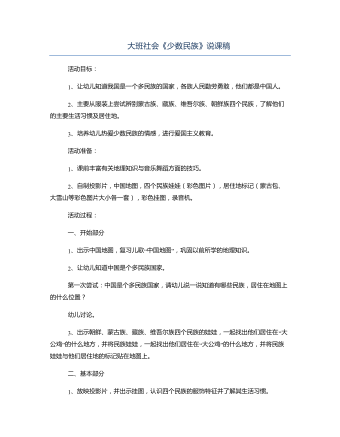
大班社会《少数民族》说课稿
基本部分是让幼儿认识各民族的服饰特征与生活习惯,通过认识、巩固加深幼儿印象。可以先让幼儿观察幻灯片,由教师的导语让幼儿尝试,进一步仔细观察挂图,在幼儿回答的基础上由教师小结,由此培养幼儿的观察能力与表达能力。然后是复习巩固,通过自制幻灯片的添色游戏,调动幼儿兴趣,快速辨认并参与游戏,这样幼儿既动手参与了游戏、活跃了课堂气氛,又复习了新课。最后为了丰富知识,让幼儿大致了解他们的音乐及舞蹈,这样满足孩子爱唱爱跳的欲望,培养音乐的感受力及欣赏、创编的能力,老师应跳出各民族的舞蹈风格,用情绪与动作感染幼儿,活跃课堂气氛。结束部分既要与开头呼应,又是全课的“点睛之笔”,再一次理解“民族大团结”的含义,通过浅显的讲解与欢快的动作,让幼儿感受“团结、欢乐”的氛围,由此完成教学目的。
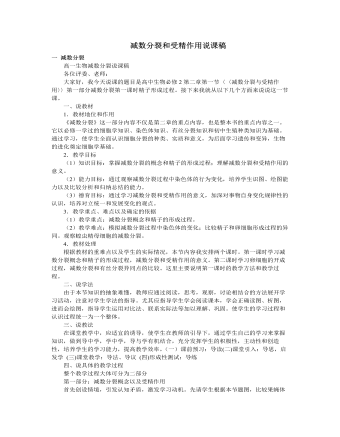
人教版高中生物必修2减数分裂和受精作用说课稿
一 减数分裂高一生物减数分裂说课稿各位评委、老师:大家好,我今天说课的题目是高中生物必修2第二章第一节〈〈减数分裂与受精作用〉〉第一部分减数分裂第一课时精子形成过程。接下来我就从以下几个方面来说说这一节课。一、说教材1.教材地位和作用《减数分裂》这一部分内容不仅是第二章的重点内容,也是整本书的重点内容之一。它以必修一学过的细胞学知识、染色体知识、有丝分裂知识和初中生殖种类知识为基础。通过学习,使学生全面认识细胞分裂的种类、实质和意义,为后面学习遗传和变异,生物的进化奠定细胞学基础。2.教学目标(1)知识目标:掌握减数分裂的概念和精子的形成过程;理解减数分裂和受精作用的意义。(2)能力目标:通过观察减数分裂过程中染色体的行为变化,培养学生识图、绘图能力以及比较分析和归纳总结的能力。
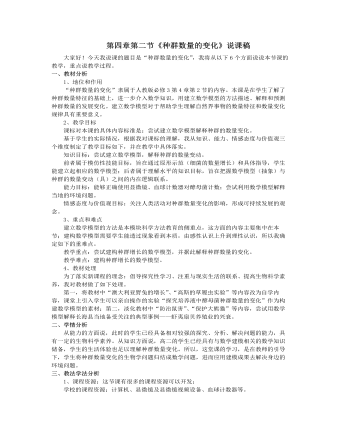
人教版高中生物必修3第四章第二节《种群数量的变化》说课稿
4、种群数量变化的其他类型我结合“种群数量下降”这个知识点对学生进行寓教。现今的自然界,许多野生生物种群的数量都在下降,为什么呢?我提供了世界人口近2000年的种群增长曲线,一切都在不言而喻中。现今社会的主题是呼吁建立和谐社会,作为生物老师,我想它不应该仅仅指人与人之间的和谐,也不应该仅仅指人与社会之间的和谐,它更应该昭示着人与自然之间的和谐,人类只有学会与自然和谐相处,才能在生物圈中享受最大的幸福。6、小结课程在实验的大背景下展开,也在实验的背景中结束,这里可以呈现出一个完整的探究思路。同时,学生思考如何实现多种预期过程,相当于对本课进行小结。五、效果预测课堂上选取的内容基于学生的生活体验,创设的情境能激发学生的兴趣,设置的问题符合学生的认知水平,有助于学生能力的提高,教学目标可以基本实现。
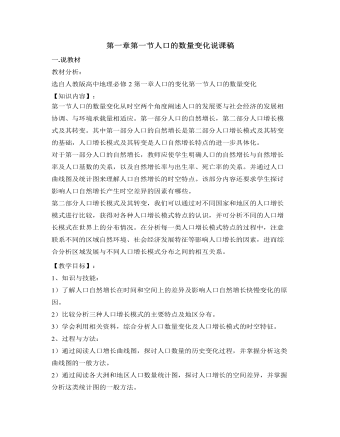
人教版高中地理必修2第一章第一节人口的数量变化说课稿
活动一:课本第三页的活动题,把学生分成几组然后让他们读图讨论,思考书上的几个问题,最后派个代表回答问题.最后教师做适当的补充:人口的自然增长不仅与人口自然增长率有关,而且还与人口基数有关.活动二:课本第七页的活动,先让两位学生阅读第六页的案例结合活动题思考问题,让几个组学生讨论所给的几个问题.让学生归纳最后教师做适当的补充.时间安排:由于本节内容不难因此整个教学过程是一节课的时间来完成的因此在教学过程中注意时间的把握,在做活动和讨论时注意把握时间,自己尽量少说废话.课堂小结通过这一节的学习,同学们正确理解和认识人口增长,增长模式和人口增长模式的转变。我们可以利用比较法、分析法来掌握,并联系现实生活,进行分析、判断,化理论知识于实践之中。
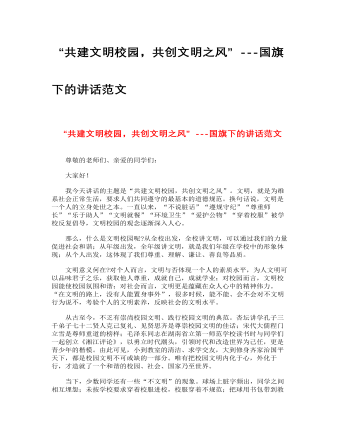
“共建文明校园,共创文明之风”---国旗下的讲话范文
我今天讲话的主题是“共建文明校园,共创文明之风”。文明,就是为维系社会正常生活,要求人们共同遵守的最基本的道德规范。换句话说,文明是一个人的立身处世之本。一直以来,“不说脏话”“遵规守纪”“尊重师长”“乐于助人”“文明就餐”“环境卫生”“爱护公物”“穿着校服”被学校反复倡导,文明校园的观念逐渐深入人心。 那么,什么是文明校园呢?从全校出发,全校讲文明,可以通过我们的力量促进社会和谐;从年级出发,全年级讲文明,就是我们年级在学校中的形象体现;从个人出发,这体现了我们尊重、理解、谦让、善良等品质。 文明意义何在?对个人而言,文明与否体现一个人的素质水平,为人文明可以品味君子之乐,获取他人尊重,成就自己,成就学业;对校园而言,文明校园能使校园氛围和谐;对社会而言,文明更是蕴藏在众人心中的精神伟力。“在文明的路上,没有人能置身事外”,很多时候,能不能、会不会对不文明行为说不,考验个人的文明素养,反映社会的文明水平。 从古至今,不乏有崇尚校园文明、践行校园文明的典范。杏坛讲学孔子三千弟子七十二贤人克己复礼、见贤思齐是尊崇校园文明的佳话;宋代大儒程门立雪是尊师重道的榜样;毛泽东同志在湖南省立第一师范学校读书时与同学们一起创立《湘江评论》,以勇立时代潮头,引领时代和改造世界为己任,更是青少年的楷模。由此可见,小到教室的清洁、求学交友,大到修身齐家治国平天下,都是校园文明不可或缺的一部分。唯有把校园文明内化于心,外化于行,才造就了一个和谐的校园、社会、国家乃至世界。

4月份国旗下讲话——美化校园 净化心灵
同学们: 春回大地,阳光明媚,当我们在春意渐浓,飘散着淡淡玉兰花香的校园中漫步时候,当我们坐在窗明几净的教室里学习时候,你一定会为自己能在这样一个洁净、优美的环境学习感到心旷神怡。去年县政府为学校的绿化建设一次性投入了几百万元,校园迅速地全面绿化美化,全校师生齐心协力为学校环境的绿化、美化、净化做出了很大的贡献。这学期校园的亮化工程竣工后,还会在校园里布设孔庙元素主题园,聪明泉,读书亭和名人雕像以及不同造型的景观文化石等,还将大大提升了学校绿化、美化的档次。我坚信,有我们全体师生的共同努力,我们校园一定会建设得更加优美。 绿,生命的颜色;绿,环保的颜色。有了绿色,便有了美丽的校园;有了绿色,便有了清新的空气;有了绿色,便有了宜人的风景;有了绿色,便有了健康的生命。因为优美的环境可以陶冶我们的性情,净化我们的心灵。我们的学习需要一个健康优美的环境,绿色则是健康优美环境的一种象征,绿色能带给我们生机和活力!走进我们如今洋溢着书香味的校园,你会被那迷人的风景所吸引,可是校园的“绿色”不仅仅是一种大自然的色彩,还应该体现在同学们的心灵上,体现在同学们的行动上。我们欣喜地看到许多同学文明守纪,爱护校园,在校园的各个角落不辞辛劳地打扫卫生,自觉地捡拾饮料盒、纸屑等,用自己勤劳的双手,用自己美丽的心灵在净化、美化着我们的校园环境。